British-American actress Elizabeth Taylor (1932-2011) began as a Hollywood child star. As an adult she came to be known for her acting talent and beauty. She was considered one of the great actresses of Hollywood's Golden Age, but she also made several films in Europe. Taylor had a much publicised private life, including eight marriages and several near death experiences.
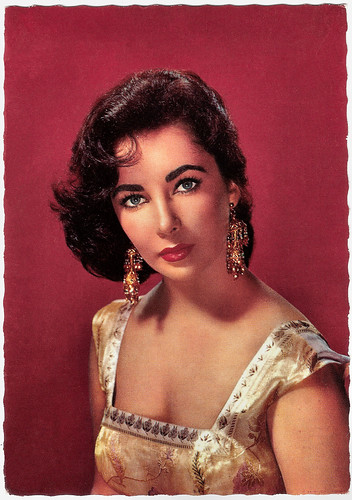
French postcard by E.D.U.G., no. 98.

German postcard by Krüger, no. 902/20.

French postcard by E.D.U.G., no. 37. Photo: publicity still for Cat on a Hot Tin Roof (Richard Brooks, 1958).
Elizabeth Rosemond Taylor was born in 1932 in Hampstead Garden, a northwestern suburb of London. She was the daughter of Francis Lenn Taylor and Sara Sothern, who were United States citizens residing in England. Her father was an art dealer, and her mother was a former stage actress. So Liz was a dual citizen of the United Kingdom and the United States, born British through her birth on British soil and a US citizen through her parents.
At the age of three, Taylor began taking ballet lessons. Shortly before the beginning of World War II, her parents decided to return to the United States. They settled in Los Angeles, California, where her father established a new art gallery, which included many paintings he shipped from England. The gallery soon attracted numerous Hollywood celebrities who appreciated its modern European paintings.
Universal Pictures gave the little, but already breathtakingly beautiful Taylor a seven-year contract, and only nine, Elizabeth appeared in her first film, There's One Born Every Minute (Harold Young, 1942). After less than a year, however, the studio fired Taylor for unknown reasons. MGM was searching for an English actress for Lassie Come Home (Fred M. Wilcox, 1943) with child-star Roddy McDowall. Taylor received the role and was offered a long-term contract.
Her first assignment was a loan-out to 20th Century Fox for a film version of the Charlotte Brontë novel Jane Eyre (Robert Stevenson, 1943) with Orson Welles. Taylor returned to England to appear in The White Cliffs of Dover (Clarence Brown, 1944). Taylor's persistence in seeking the role of Velvet Brown in MGM's National Velvet (Clarence Brown, 1944) made her a star at the age of 12. Her character was a young girl, training her beloved horse to win the Grand National. The film costarred Mickey Rooney and English newcomer Angela Lansbury,and became a great success.
Next, she was cast in another animal film, Courage of Lassie (Fred M. Wilcox, 1946). The film's success led to another contract for Taylor paying her $750 per week. Her roles as the neurotic Mary Skinner in a loan-out to Warner Brothers' Life With Father (Michael Curtiz, 1947), Cynthia Bishop in Cynthia (Robert Z. Leonard, 1947), Carol Pringle in A Date with Judy (Richard Thorpe, 1948), and Susan Prackett in Julia Misbehaves (Jack Conway, 1948) were all successful. Taylor earned a reputation as a consistently successful adolescent actress, with a promising career. Her portrayal of Amy in the American classic Little Women (Mervyn LeRoy, 1949) was her last adolescent role.
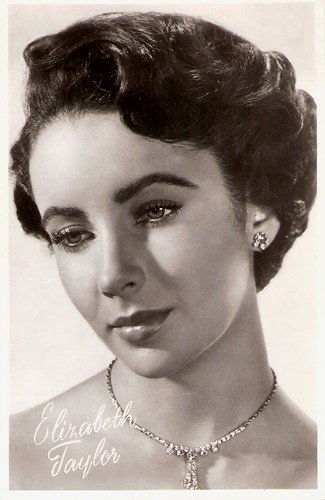
Dutch postcard. Photo: MGM.
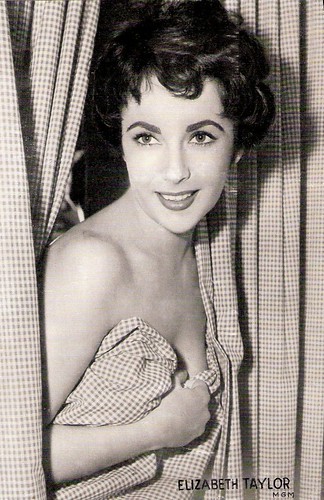
Dutch postcard. Photo: MGM.
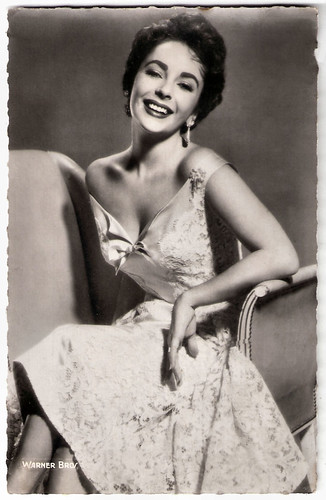
French postcard by Editions du Globe, no. 524. Photo: Warner Bros.
In October 1948, Elizabeth Taylor sailed to England to film Conspirator (1949). Taylor made an easy transition to adult roles. Conspirator failed at the box office, but 16-year-old Taylor's portrayal of a 21-year-old debutante who unknowingly marries a communist spy, was praised by critics for her first adult lead in a film. Her first box office success in an adult role came as Kay Banks in the comedy Father of the Bride (Vincente Minnelli, 1950), alongside Spencer Tracy. The film spawned a sequel, Father's Little Dividend (Vincente Minnelli, 1951), which also did well at the box office, but it would be Taylor's next picture that would set the course for her career as a dramatic actress.
For her performance in A Place in the Sun (George Stevens, 1951), Taylor was hailed. She played Angela Vickers, a spoiled socialite who comes between George Eastman (Montgomery Clift) and his poor, pregnant factory-working girlfriend Alice Tripp (Shelley Winters). The film was based on Theodore Dreiser's novel An American Tragedy. Critic A.H. Weiler wrote in The New York Times: "Elizabeth's delineation of the rich and beauteous Angela is the top effort of her career".
After some disappointingly run-of-the-mill films, a more substantial role followed opposite Rock Hudson and James Dean in the epic Giant (George Stevens, 1956). Taylor was nominated for an Academy Award for Best Actress four years in a row for Raintree County (Edward Dmytryk, 1957) opposite Montgomery Clift; Cat on a Hot Tin Roof (Richard Brooks, 1958) opposite Paul Newman; Suddenly, Last Summer (Joseph L. Mankiewicz, 1959) with Montgomery Clift and Katharine Hepburn; and finally winning for BUtterfield 8 (Daniel Mann, 1960). The film co-starred Laurence Harvey and her then-husband Eddie Fisher. Suddenly, Last Summer's success placed Taylor among the box-office top-ten, and she remained there almost every year for the next decade.

Dutch postcard by Filmphoto Service, Amsterdam, no. KF 41. Photo: MGM.
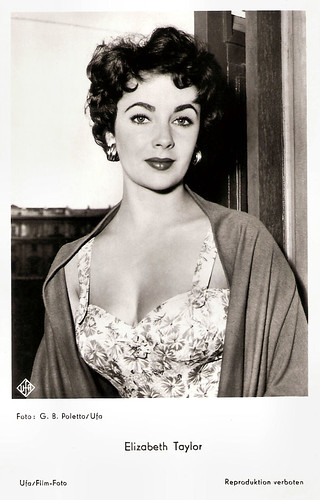
German postcard by Ufa, Berlin-Tempelhof, no. FK 3515. Photo: G.B. Poletto / Ufa.

French postcard by Editions P.I., Paris, no. 1051. Photo: John Everton / Ufa.
In 1960, Elizabeth Taylor became the highest-paid actor in Hollywood when she signed a $1 million dollar contract to play the title role in 20th Century Fox's lavish production of Cleopatra (Joseph L. Mankiewicz, 1963). During the filming, she began a romance with her future husband Richard Burton, who played Mark Antony in the film. The romance received much attention from the tabloid press, as both were married at the time. Taylor ultimately received $7 million for her role.
Her second Academy Award, also for Best Actress in a Leading Role, was for her performance as Martha in Who's Afraid of Virginia Woolf? (Mike Nichols, 1966), playing opposite then-husband Richard Burton. Taylor saw the film as her chance to really act, because her character was to be twenty years older. She added gray hairs and transformed herself both physically and vocally: she intentionally gained weight, minimized makeup, and added excessive mascara to her eyes along with smudgy bags beneath them.
Taylor and Burton appeared together in six other films during the decade, among them The V.I.P.s (Anthony Asquith, 1963), The Sandpiper (Vincente Minnelli, 1965), and The Taming of the Shrew (Franco Zeffirelli, 1967). By 1967 their films had earned $200 million at the box office. Their next films Doctor Faustus (Richard Burton, Nevill Coghill, 1967), The Comedians (Peter Glenville, 1967) and Boom! (Joseph Losey, 1968), however, all failed at the box office.
Taylor appeared in John Huston's Reflections in a Golden Eye (1967) opposite Marlon Brando and Secret Ceremony (Joseph Losey, 1968) opposite Mia Farrow. By the end of the decade her box-office drawing power had considerably diminished, as evidenced by the failure of The Only Game in Town (George Stevens, 1970), with Warren Beatty.
Throughout the 1970s, Taylor continued to star in numerous theatrical films, such as Zee and Co. (Brian G. Hutton, 1972) with Michael Caine, Ash Wednesday (Larry Peerce, 1973), The Blue Bird (George Cukor, 1976) with Jane Fonda and Ava Gardner, and A Little Night Music (Harold Prince, 1977). With Richard Burton, she co-starred in Under Milk Wood (Andrew Sinclair, 1972) and Hammersmith Is Out (Peter Ustinov, 1972).
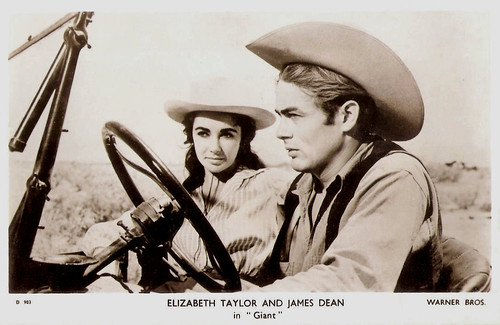
British postcard in the Picturegoer Series, London, no. D 903. Photo: Warner Bros. Publicity still for Giant (George Stevens, 1956) with James Dean.
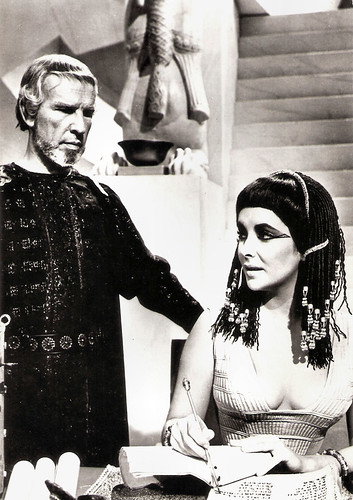
Czech postcard by UPF, Praha / Press Photo. Photo: publicity still for Cleopatra (Joseph L. Mankiewicz, 1963) with Hume Cronyn.

Belgian postcard by SB (Uitgeverij Best), Antwerpen (Antwerp). Photo: still for Cleopatra (Joseph L. Mankiewicz, 1963).
In 1980, Elizabeth Taylor starred in the mystery film The Mirror Crack'd (Guy Hamilton, 1980), based on an Agatha Christie novel. In 1985, she played movie gossip columnist Louella Parsons in the TV film Malice in Wonderland (Gus Trikonis, 1985) opposite Jane Alexander, who played Hedda Hopper. Taylor appeared in the miniseries North and South (Richard T. Heffron, 1985) and her last theatrical film was The Flintstones (Brian Levant, 1994).
Taylor also acted on the stage, making her Broadway and West End debuts in 1982 with a revival of Lillian Hellman's The Little Foxes. She was then in a production of Noël Coward's Private Lives (1983), in which she starred with her former husband, Richard Burton. The student-run Burton Taylor Studio in Oxford was named for the famous couple after Burton appeared as Doctor Faustus in the Oxford University Dramatic Society production of the Marlowe play. Taylor played the ghostly, wordless Helen of Troy, who is entreated by Faustus to make him immortal with a kiss.
In 2007, Taylor acted onstage again, appearing opposite James Earl Jones in a benefit performance of the A. R. Gurney play Love Letters. The event's goal was to raise $1 million for Taylor's AIDS foundation. Tickets for the show were priced at $2,500, and more than 500 people attended. The event happened to coincide with the 2007 Writers Guild of America strike and, rather than cross the picket line, Taylor requested a "one night dispensation". The Writers Guild agreed not to picket the Paramount Pictures lot that night to allow for the performance.
In the early 1980s, Elizabeth Taylor had moved to Bel Air, California, which was her residence until her death. Taylor was married eight times to seven husbands, including actor Michael Wilding, producer Michael Todd, singer-actor Eddie Fisher and Richard Burton, whom she married twice. In 2011, she died at the age of 79 in Los Angeles, surrounded by her four children.
Trailer Suddenly, Last Summer (1959). Source: dameelizabethtaylor (YouTube).
Trailer Cleopatra (1963). Source: dameelizabethtaylor (YouTube).
Sources: Wikipedia and IMDb.

French postcard by E.D.U.G., no. 98.

German postcard by Krüger, no. 902/20.

French postcard by E.D.U.G., no. 37. Photo: publicity still for Cat on a Hot Tin Roof (Richard Brooks, 1958).
A dual citizen
Elizabeth Rosemond Taylor was born in 1932 in Hampstead Garden, a northwestern suburb of London. She was the daughter of Francis Lenn Taylor and Sara Sothern, who were United States citizens residing in England. Her father was an art dealer, and her mother was a former stage actress. So Liz was a dual citizen of the United Kingdom and the United States, born British through her birth on British soil and a US citizen through her parents.
At the age of three, Taylor began taking ballet lessons. Shortly before the beginning of World War II, her parents decided to return to the United States. They settled in Los Angeles, California, where her father established a new art gallery, which included many paintings he shipped from England. The gallery soon attracted numerous Hollywood celebrities who appreciated its modern European paintings.
Universal Pictures gave the little, but already breathtakingly beautiful Taylor a seven-year contract, and only nine, Elizabeth appeared in her first film, There's One Born Every Minute (Harold Young, 1942). After less than a year, however, the studio fired Taylor for unknown reasons. MGM was searching for an English actress for Lassie Come Home (Fred M. Wilcox, 1943) with child-star Roddy McDowall. Taylor received the role and was offered a long-term contract.
Her first assignment was a loan-out to 20th Century Fox for a film version of the Charlotte Brontë novel Jane Eyre (Robert Stevenson, 1943) with Orson Welles. Taylor returned to England to appear in The White Cliffs of Dover (Clarence Brown, 1944). Taylor's persistence in seeking the role of Velvet Brown in MGM's National Velvet (Clarence Brown, 1944) made her a star at the age of 12. Her character was a young girl, training her beloved horse to win the Grand National. The film costarred Mickey Rooney and English newcomer Angela Lansbury,and became a great success.
Next, she was cast in another animal film, Courage of Lassie (Fred M. Wilcox, 1946). The film's success led to another contract for Taylor paying her $750 per week. Her roles as the neurotic Mary Skinner in a loan-out to Warner Brothers' Life With Father (Michael Curtiz, 1947), Cynthia Bishop in Cynthia (Robert Z. Leonard, 1947), Carol Pringle in A Date with Judy (Richard Thorpe, 1948), and Susan Prackett in Julia Misbehaves (Jack Conway, 1948) were all successful. Taylor earned a reputation as a consistently successful adolescent actress, with a promising career. Her portrayal of Amy in the American classic Little Women (Mervyn LeRoy, 1949) was her last adolescent role.

Dutch postcard. Photo: MGM.

Dutch postcard. Photo: MGM.

French postcard by Editions du Globe, no. 524. Photo: Warner Bros.
An easy transition to adult roles
In October 1948, Elizabeth Taylor sailed to England to film Conspirator (1949). Taylor made an easy transition to adult roles. Conspirator failed at the box office, but 16-year-old Taylor's portrayal of a 21-year-old debutante who unknowingly marries a communist spy, was praised by critics for her first adult lead in a film. Her first box office success in an adult role came as Kay Banks in the comedy Father of the Bride (Vincente Minnelli, 1950), alongside Spencer Tracy. The film spawned a sequel, Father's Little Dividend (Vincente Minnelli, 1951), which also did well at the box office, but it would be Taylor's next picture that would set the course for her career as a dramatic actress.
For her performance in A Place in the Sun (George Stevens, 1951), Taylor was hailed. She played Angela Vickers, a spoiled socialite who comes between George Eastman (Montgomery Clift) and his poor, pregnant factory-working girlfriend Alice Tripp (Shelley Winters). The film was based on Theodore Dreiser's novel An American Tragedy. Critic A.H. Weiler wrote in The New York Times: "Elizabeth's delineation of the rich and beauteous Angela is the top effort of her career".
After some disappointingly run-of-the-mill films, a more substantial role followed opposite Rock Hudson and James Dean in the epic Giant (George Stevens, 1956). Taylor was nominated for an Academy Award for Best Actress four years in a row for Raintree County (Edward Dmytryk, 1957) opposite Montgomery Clift; Cat on a Hot Tin Roof (Richard Brooks, 1958) opposite Paul Newman; Suddenly, Last Summer (Joseph L. Mankiewicz, 1959) with Montgomery Clift and Katharine Hepburn; and finally winning for BUtterfield 8 (Daniel Mann, 1960). The film co-starred Laurence Harvey and her then-husband Eddie Fisher. Suddenly, Last Summer's success placed Taylor among the box-office top-ten, and she remained there almost every year for the next decade.

Dutch postcard by Filmphoto Service, Amsterdam, no. KF 41. Photo: MGM.

German postcard by Ufa, Berlin-Tempelhof, no. FK 3515. Photo: G.B. Poletto / Ufa.

French postcard by Editions P.I., Paris, no. 1051. Photo: John Everton / Ufa.
Cleopatra
In 1960, Elizabeth Taylor became the highest-paid actor in Hollywood when she signed a $1 million dollar contract to play the title role in 20th Century Fox's lavish production of Cleopatra (Joseph L. Mankiewicz, 1963). During the filming, she began a romance with her future husband Richard Burton, who played Mark Antony in the film. The romance received much attention from the tabloid press, as both were married at the time. Taylor ultimately received $7 million for her role.
Her second Academy Award, also for Best Actress in a Leading Role, was for her performance as Martha in Who's Afraid of Virginia Woolf? (Mike Nichols, 1966), playing opposite then-husband Richard Burton. Taylor saw the film as her chance to really act, because her character was to be twenty years older. She added gray hairs and transformed herself both physically and vocally: she intentionally gained weight, minimized makeup, and added excessive mascara to her eyes along with smudgy bags beneath them.
Taylor and Burton appeared together in six other films during the decade, among them The V.I.P.s (Anthony Asquith, 1963), The Sandpiper (Vincente Minnelli, 1965), and The Taming of the Shrew (Franco Zeffirelli, 1967). By 1967 their films had earned $200 million at the box office. Their next films Doctor Faustus (Richard Burton, Nevill Coghill, 1967), The Comedians (Peter Glenville, 1967) and Boom! (Joseph Losey, 1968), however, all failed at the box office.
Taylor appeared in John Huston's Reflections in a Golden Eye (1967) opposite Marlon Brando and Secret Ceremony (Joseph Losey, 1968) opposite Mia Farrow. By the end of the decade her box-office drawing power had considerably diminished, as evidenced by the failure of The Only Game in Town (George Stevens, 1970), with Warren Beatty.
Throughout the 1970s, Taylor continued to star in numerous theatrical films, such as Zee and Co. (Brian G. Hutton, 1972) with Michael Caine, Ash Wednesday (Larry Peerce, 1973), The Blue Bird (George Cukor, 1976) with Jane Fonda and Ava Gardner, and A Little Night Music (Harold Prince, 1977). With Richard Burton, she co-starred in Under Milk Wood (Andrew Sinclair, 1972) and Hammersmith Is Out (Peter Ustinov, 1972).

British postcard in the Picturegoer Series, London, no. D 903. Photo: Warner Bros. Publicity still for Giant (George Stevens, 1956) with James Dean.

Czech postcard by UPF, Praha / Press Photo. Photo: publicity still for Cleopatra (Joseph L. Mankiewicz, 1963) with Hume Cronyn.

Belgian postcard by SB (Uitgeverij Best), Antwerpen (Antwerp). Photo: still for Cleopatra (Joseph L. Mankiewicz, 1963).
Malice in Wonderland
In 1980, Elizabeth Taylor starred in the mystery film The Mirror Crack'd (Guy Hamilton, 1980), based on an Agatha Christie novel. In 1985, she played movie gossip columnist Louella Parsons in the TV film Malice in Wonderland (Gus Trikonis, 1985) opposite Jane Alexander, who played Hedda Hopper. Taylor appeared in the miniseries North and South (Richard T. Heffron, 1985) and her last theatrical film was The Flintstones (Brian Levant, 1994).
Taylor also acted on the stage, making her Broadway and West End debuts in 1982 with a revival of Lillian Hellman's The Little Foxes. She was then in a production of Noël Coward's Private Lives (1983), in which she starred with her former husband, Richard Burton. The student-run Burton Taylor Studio in Oxford was named for the famous couple after Burton appeared as Doctor Faustus in the Oxford University Dramatic Society production of the Marlowe play. Taylor played the ghostly, wordless Helen of Troy, who is entreated by Faustus to make him immortal with a kiss.
In 2007, Taylor acted onstage again, appearing opposite James Earl Jones in a benefit performance of the A. R. Gurney play Love Letters. The event's goal was to raise $1 million for Taylor's AIDS foundation. Tickets for the show were priced at $2,500, and more than 500 people attended. The event happened to coincide with the 2007 Writers Guild of America strike and, rather than cross the picket line, Taylor requested a "one night dispensation". The Writers Guild agreed not to picket the Paramount Pictures lot that night to allow for the performance.
In the early 1980s, Elizabeth Taylor had moved to Bel Air, California, which was her residence until her death. Taylor was married eight times to seven husbands, including actor Michael Wilding, producer Michael Todd, singer-actor Eddie Fisher and Richard Burton, whom she married twice. In 2011, she died at the age of 79 in Los Angeles, surrounded by her four children.
Trailer Suddenly, Last Summer (1959). Source: dameelizabethtaylor (YouTube).
Trailer Cleopatra (1963). Source: dameelizabethtaylor (YouTube).
Sources: Wikipedia and IMDb.
No comments:
Post a Comment